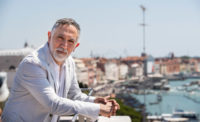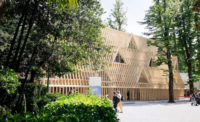Judging from today’s award ceremony, the jury for the Golden Lions at this year’s Venice Architecture Biennale was clearly intent on awarding the ideas behind exhibits as much as the exhibits themselves. Kazuyo Sejima, co-founder of the firm SANAA and president of the international jury, awarded the best pavilion to the United Arab Emirates for Wetland (curated by former RECORD Vanguards Wael Al Awar and Kenichi Teramoto), declaring it “a bold experiment which encourages us to think about the relationship between waste and production, and opens new construction possibilities between craft and high technology.”
It was perhaps a surprising choice, given that the more formal gestures of other national contributions, such as Belgium and the U.S. had attracted plaudits. The UAE’s pavilion, however, showcased a promising technology: an innovative cement made of recycled industrial salt water. The jury was clearly taken with this technology’s potential to reduce the carbon output of the construction industry as opposed to its current aesthetic qualities: a noble approach from the architects, even if the exhibit itself resembles an upturned bowl of All Bran cereal.
But, as Hashim Sarkis, curator of the How will we live together? main exhibition put it, “architecture is always proposing a future.”
The Golden Lion for the best participant in the main exhibition went to Berlin-based firm Raumlabor for, according to the jury citation, “an inspiring collaborative approach that argues for participation, regeneration and collective responsibility.” Specifically, this was for the documentation exhibited which emerged from work done in organizing and subtly proposing alternative uses for two areas in Berlin: one near the former Tempelhof airport, and another just off Alexanderplatz. The first resulted in a series of stilted structures over a flooded meadow and the latter an evolving series of installations and exhibitions in a Modernist urban plaza.
Raumlabor has been influential in investigating how community participation is organized for planning. It has done so by building temporary structures in the face of Berlin’s commercial development since the 1990s, which explains why this may have felt like a Lifetime Achievement Award (it was actually Rafael Moneo who received that accolade this year.)
Of course, the jury—which also included Sandra Barclay, Lamia Joreige, Lesley Lokko and Luca Molinari—was not immune to more formal architectural national contributions. It also acknowledged the pavilions of Russia and the Philippines with special mentions: the former for an extensive remodeling of its pavilion itself and the latter for one of several explorations from different nations into timber construction exhibited in Venice; this time a full-built home.
The Silver Lion for a promising young participant in the 17th exhibition, How will we live together?, was given to Foundation for Achieving Seamless Territory (FAST) for their exhibit Watermelons, Sardines, Crabs, Sands, and Sediments: Border Ecologies and the Gaza Strip. A special mention was given to Cave_bureau from Nairobi for their exhibit, The Anthropocene Museum: Exhibit 3.0 Obsidian Rain.
The Venice Architecture Biennale continues until November 21, 2021.





Post a comment to this article
Report Abusive Comment